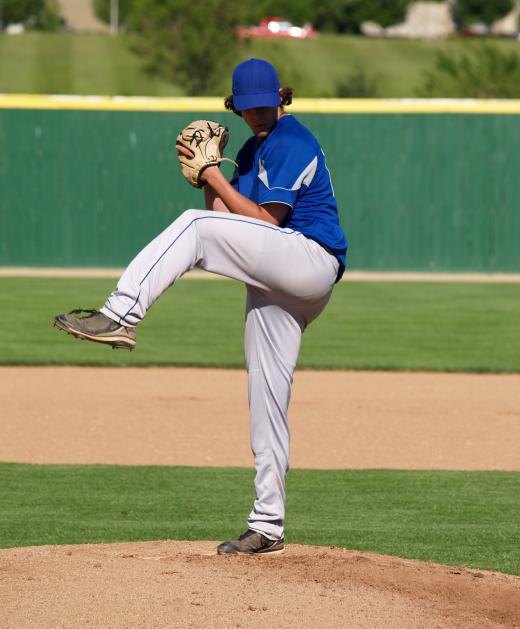At Sports&Hobbies, we're committed to delivering accurate, trustworthy information. Our expert-authored content is rigorously fact-checked and sourced from credible authorities. Discover how we uphold the highest standards in providing you with reliable knowledge.
What are Plyometrics?
Plyometrics are exercises which are intended to increase muscular power. A number of athletes such as boxers integrate plyometrics into their training regimen. When practiced safely, the exercises allow athletes to bring considerable power into their sports activities, which can be a major advantage. Because plyometrics are high intensity exercises, only athletes who are in good condition should attempt them, preferably under the guidance of a trainer or instructor. Athletes should also be attuned to their bodies, checking for signs of injury and adjusting their routine as needed.
In order to move a muscle, a contraction is required. Athletes have noticed that this contraction is much more powerful immediately after a muscle has been stretched, in what is termed an “eccentric contraction.” Plyometrics trains athletes to stretch their muscles and then quickly contract them to create an explosive burst of power which exceeds the raw strength of an athlete. It is the principle behind incredibly fast baseball pitches, hard punches, and high jumping, among many other athletic feats.

Since plyometrics is all about cultivating bursts of power, the exercises take the form of explosive movements such as jumps, hops, and bounds. The main goal of training in plyometrics is to shorten the time between stretching and contracting a muscle, converting strength into speed for more power. In this sense, the musculotendinous system of the body is re-trained, along with the neurological system, which normally limits force in the interest of protecting the body from injury.

It is very important to properly warm up before attempting plyometric exercises, because the movements can damage muscles which have not been properly stretched and conditioned. In addition, the athlete must be in good shape, and of an optimal age and body weight. Since the exercises are easy to perform inappropriately, athletes should be carefully instructed and monitored while they learn plyometrics. In addition, properly padded shoes should be used in a padded and reinforced workout space.

When done properly, plyometrics will increase agility and coordination as well as power. It is used as a supplement to other forms of physical conditioning, and it is crucial to cool down properly after the exercises as well. Athletes who are interested in exploring plyometrics should talk to their coaches, who will be able to assess whether or not the athlete is ready for the activity. In addition, a coach can recommend specific exercises or a plyometric trainer who can establish a safe and productive routine.
AS FEATURED ON:
AS FEATURED ON:
















Discussion Comments
My sister is on her university's swim team, and we recently talked about her water plyometrics workout. I asked her how she could possibly increase her muscle performance with a water workout, and she filled me in on some interesting details.
She said that when a person is in water, they only bear a fraction of their own body weight. The water supports them when they move down and acts against them when they jump up. So, depending on a person's ability, they can choose to work out in deep water for more support or in shallow water so they can use more of their body's own power.
She told me that water plyometrics are excellent for athletes recovering from knee injuries. The impact on the knees is much lower than on land.
@orangey03 – Plyometrics certainly are not for everyone, but I think it's good that you want to try a few and see if you can work your way up to an exercise program. I can share with you a few of the exercises I do.
The first one I learned involves squatting and jumping. You squat first, and then you jump up as high as you can, but while you are up in the air, you have to bring your legs to your chest before landing. Once you land, you have to bounce back up and do it all over again. The whole process should be seamless, without any pauses.
For my second exercise, I lay a piece of rope on the floor. With my feet close together, I hop over the rope and back again as fast as I can. I stick my arms out to help me stay balanced.
These exercises were challenging in the beginning, to say the least. You will see when you first try them how much they affect your muscles and how quickly you get out of breath. Don't let that discourage you, though. If you keep at it, you will become accustomed to the tough workout.
This type of exercise sounds intriguing! I want to know more about it before I sign up for a class or purchase a video, though, because I might not be physically able to participate.
Can anyone tell me about some specific plyometrics? I would probably do better working at my own pace than under the direction of a trainer, because I know I will have a lot of weakness to get past and strength to build before I can join any groups or endure any training by a coach.
Plyometrics is definitely not for me. I have trouble just walking half a mile at a moderate pace without injuring myself. I can't imagine what all I would break by attempting this type of exercise!
It sounds like brainwashing. If you are reconditioning the mind to allow you to do more forceful activities, then you are probably using a portion of your brain that normally you don't have access to, and that sounds risky.
Post your comments